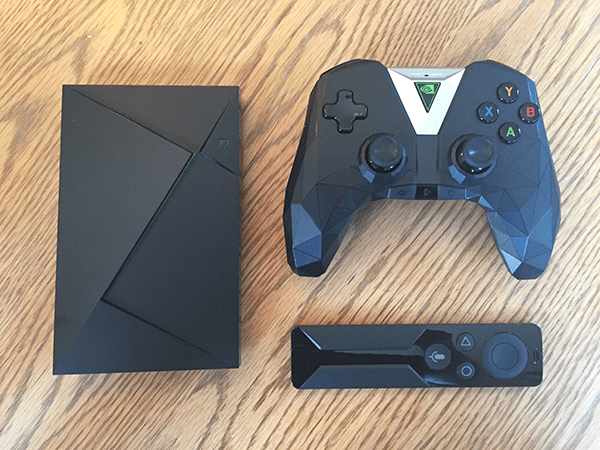But even dominant devices need occasional updates, and this past year saw the release of Nvidia’s next-generation Shield. The new Shield features a smaller form factor (though the Nvidia Shield Pro, which features 500GB of storage, is larger) a tweaked the controller, and a few hardware improvements. Is all this enough for the Shield to continue dominating its niche? Is it worth updating from the old Shield to the new one? Let’s go about answering those questions in the form of a complete Nvidia Shield review.
Nvidia Shield Review
The Device
The old Nvidia Shield was a larger and clunkier device than non-gaming peers like Roku and Fire TV – which was understandable, given the powerful hardware inside the Shield. Pick up the new model, however, and you’ll notice right away that something has changed: Honey, they shrunk the Shield.

The 500 GB Nvidia Shield Pro is still a chunky boy, but this regular Nvidia Shield was pleasantly normal-sized, and looked far less geeky next to the TV than its older brother ever did. The same can’t be said for the game controller, which is now as ugly as sin.
The controller doesn’t feel as bad as it looks. It’s fairly comfortable, and overall, I like it better than the last generation’s version. It doesn’t have anything on the controllers from the major console manufacturers, though, and I do have some small gripes. It feels a little light and a little thin in the grips. It’s also oddly angular. See the triangular panels outlined by the lines on the controller? They’re each a flat surface. It gives the controller a kind of polygon look. It’s a matter of taste, and some consumers will probably find it cool. Certainly, Nvidia must have. Me? Not so much.
The remote, on the other hand, is pretty elegant. It runs on coin-cell batteries (like watch batteries). That seems like an annoying type of battery to have to go buy replacements for, but Nvidia claims the batteries will last you a calendar year, so at least this isn’t a near-term problem. Happily, the remote is now included in the box – in the last generation, the remote was an accessory that was sold separately.
Like a frustratingly large number of other streaming boxes, the Nvidia Shield has no HDMI cord. The last generation Shield actually did include the HDMI cable, so I guess that’s the trade we made for the included remote. The package does include a power cord and a charging cord for the gaming controller.
Other than the form factor and the included remote, there’s not much that’s changed about the Shield between generations. The new device has the same processing power and runs the exact same software as the old one.
User Experience
Setting the Nvidia Shield is pretty easy, especially if you have an Android tablet or phone on hand. With an Android device, you can use the Google app to auto-detect the device. You can set up Wi-Fi and log into your Google account on the Android screen, saving you a bit of time. You can also use your Android device as a remote control with the aid of an app called (wait for it) Android TV Remote Control. Regular set-up is similar, but happens on the Shield itself.
The Google connection comes courtesy of the Nvidia Shield’s platform: Android TV. Android TV is, as the name suggests, an Android-based platform that is designed for streaming devices. It’s app-based, and doesn’t have a ton of menus of its own. The Nvidia Shield has a solid and competent operating system, but I generally feel that Android TV lags a bit behind the user-friendly Roku and the more complex Fire TV OS in most departments. The app library is great, but it has little problems – for instance, when I went to enter my billing information, the on-screen keyboard covered the text boxes I was using. I had to hit back, read what it wanted (“zip code,” “phone number,” etc.), then hit the select button and go back to typing.
I called Android TV “pleasant and straightforward” in my last Nvidia Shield review. I called it “good, but not great” in my AirTV review. Both seem statements still feel about right to me. You won’t hate Android TV, and you won’t love it. It’s fine. It’s not the selling point of the Nvidia Shield.
For the most part, the Nvidia shield operates exactly how you’d assume: select app, use app, etc. One nice touch, though, comes when playing a game through Nvidia GeForce NOW: hit the home button and the home screen appears over your game. You can choose another app or just hit the home button again to return to your game, right where you left off.
It’s also worth noting that the Nvidia Shield, like Fire TV and the higher end of Roku’s lineup, features a remote with a microphone for voice searching.
Content
Android TV has a very healthy app library. All of the usual suspects are here: Netflix, HBO, Hulu, Sling TV, MLB.TV, and many others. Even Amazon is here. It’s so nice to see everyone getting along. (Amazon was a late arrival on the Shield, but when it showed up it came to both this and the old generation of devices, so you don’t have to upgrade to get it).
The apps are appealing and run well on the Nvidia Shield. As we’ll touch on in a moment, streaming quality was fine, too. But all of this is also true of devices that cost a fraction of the $199.99 that the Shield will set you back, so, like the OS, streaming isn’t the selling point.
The real selling point, of course, is the Nvidia Shield’s gaming capabilities. This is a device that comes with a gaming controller by default, and the gaming options on the Shield put those on every other streaming device to shame. It’s impossible to understate just how brutally the Shield blows the competition out of the water in gaming. The closest competitor is probably the Fire TV, which offers super-casual, super-simple mobile-style games of the sort that you’d see on the Roku as well as a few console ports of the sort you’d see in mobile apps libraries. The Shield has all of that, too, and a whole lot more.
The Android TV app library has you covered for simple mobile games and console ports of titles like Grand Theft Auto: San Andreas and old Final Fantasy games. There are some surprisingly complete games available through Google Play.
Then there’s Nvidia GeForce NOW, a video game streaming service that Nvidia runs. Nvidia GeForce NOW is basically trying to use the Netflix model for video games, and it succeeds remarkably well. It streams reliably (more on that in the next section) and offers an alright catalog of free games. More streaming games are available for purchase, meaning you’re paying more on top of the monthly subscription fee. That’s a bummer, but it makes sense – $7.99/month would be pretty cheap for a huge gaming library.
And on top of all of this, the Nvidia Shield also allows you to cast your own games from your gaming PC to the Nvidia Shield, provided that your PC has a Nvidia GeForce GTX GPU.
Streaming Quality
The Nvidia Shield is 4K-capable. 4K isn’t everywhere yet, but it’s becoming more and more common every day. The 4K capabilities on this year’s Nvidia Shield capabilities will help the device stay relevant for a while. Impressively, this isn’t even new – the last generation had 4K, too!
As for streaming consistency, the Nvidia Shield streamed like a dream. Even on Wi-Fi, it loaded streaming videos fast and played them smoothly in crisp HD.
Video isn’t the only thing that the Shield can stream, of course: as I mentioned in the content section, it can also stream games on Nvidia’s GeForce NOW service. Hardcore gamers will want to play with a wired connection, but just to be a tough customer, I tried it with Wi-Fi as well. Nvidia Shield will warn you if your Wi-Fi is weak when you try to start a game, so you’ll know what you’re getting into. If the Wi-Fi lags you while you’re playing, an icon in the corner of the screen will let you know what’s going on.
Even on weak Wi-Fi, I was pretty impressed with Nvidia GeForce NOW. For the most part, it streamed smoothly and felt like playing a video game on a regular console or PC. And on a wired connection, the service feels flawless.
Price
The Nvidia Shield is powerful, useful, and fun. It is a lot of good things. Cheap is not one of those things.
The Nvidia Shield is $199.99. This is the spot in the review where I usually use a comparable device as a benchmark, but that’s not really possible in a Nvidia Shield review – there really is no true direct competitor to this device. $200 is a good seventy bucks or so north of what you’d pay for even the priciest non-gaming streaming boxes, but the Nvidia Shield is a gaming-focused streaming box, and it’s the only important device of its kind.
If you thought $199.99 was rough, skip the rest of this section. We reviewed the Nvidia Shield, but Nvidia also offers a larger, high-end device called the Nvidia Shield Pro. The Pro includes 500 GB of storage. That’s 484 GB more than our cute little regular Shield, but the price rises with the storage: $299.99, which would be an unheard-of price for a streaming box had Nvidia not priced its last generation in the exact same way.
Nvidia GeForce Now, the subscription streaming service for video games that works with the Shield, is $7.99/month after a one-month free trial.
Why choose Nvidia Shield?
Buy on AmazonVerdict
Do you want to spend $199.99 plus tax on best streaming box for gamers? What about $299.99 for a version with more storage?
Only you can decide if you want to spend a bunch of dough on a streaming-oriented gaming box. But if you do decide to do so, the Nvidia Shield is, without question, the box to buy. The Nvidia Shield does stuff that no other product on the market does, and it does it well. This was true before 2017 (owners of the last-generation Shield do not need to upgrade, in my opinion). It remains true now. This box would dominate the streaming/gaming market even if it had reasonable competition, and it does not. The Nvidia Shield is king.
And it’s also $199.99 plus tax, so do with this information what you will.
A Quick Disclosure
It’s common practice for companies to send out free copies of their products for blogs, magazines, and newspapers to review. Like everyone else in this business, we accept review copies. We always disclose what we receive for free, and we never accept cash or other considerations in exchange for reviews. We do not sell or profit off of review copies. Nvidia sent us a copy of the Shield (16 GB model) for use in this review.



The links provided do not show the version you have a picture of. Also, Best buy has the Pro for $199 but says its only 16GB, no sign of a 500GB? Am I confusing two products, or is this a new release? If so, does it still have the AI upscaling?
Does it work as a movie jukebox.
When is next update for Nvidia Shield expected?
The software contains advertising throughout which is annoying as all get out.
I would reduce the rating by at least a star just for that alone.